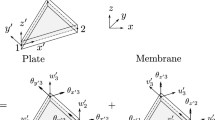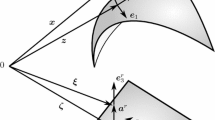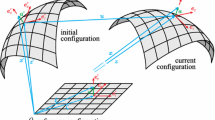Abstract
The implementation of the conforming radial point interpolation method (CRPIM) for spatial thick shell structures is presented in this paper. The formulation of the discrete system equations is derived from a stress-resultant geometrically exact theory of shear flexible shells based on the Cosserat surface. A discrete singularity-free mapping between the five degrees of freedom of the Cosserat surface and the normal formulation with six degrees of freedom is constructed by exploiting the geometry connection between the orthogonal group and the unit sphere. A radial basis function is used in both the construction of shape functions based on arbitrarily distributed nodes as well as in the surface approximation of general spatial shell geometries. The major advantage of the CRPIM is that the shape functions possess a delta function property and the interpolation function obtained passes through all the scattered points in the influence domain. Thus, essential boundary conditions can be easily imposed, as in finite element method. A range of shape parameters is studied to examine the performance of CRPIM for shells, and optimal values are proposed. The phenomena of shear locking and membrane locking are illustrated by presenting the membrane and shear energies as fractions of the total energy. Several benchmark problems for shells are analyzed to demonstrate the validity and efficiency of the present CRPIM. The convergence rate of the results using a Gaussian (EXP) radial basis is relatively high compared to those using a multi-quadric (MQ) radial basis for the shell problems.
Similar content being viewed by others
References
Yang, H.T.Y., Saigal, S., Liaw, D.G.: Advances of thin shell finite elements and some applications–version I. Comput Struct 35, 481–504 (1990)
Simo, J., Fox, D.D.: On a stress resultant geometrically exact shell model, part I: formulation and optimal parameterization. Comput Methods Appl Mech Eng 72, 267–304 (1989)
Belytschko, T., Lu, Y.Y., Gu, L.: Element-free Galerkin methods. Int J Numer Methods Eng 37, 229–256 (1994)
Belytschko, T., Gu, L., Lu, Y.Y.: Fracture and crack growth by element-free Galerkin methods. Int Model Simul Mater Sci Eng 2, 519–534 (1994)
Krysl, P., Belytschko, T.: Analysis of thin shells by element-free Galerkin method. Int J Solids Struct 33, 3057–3080 (1996)
Liu, G.R.: Mesh free methods: moving beyond the finite element method. CRC, Boca Raton, USA (2002)
Liu, G.R., Gu, Y.T., Dai, K.Y.: Assessment and applications of point interpolation methods for computational mechanics. Int J Numer Methods Eng 59, 1373–1397 (2004)
Powell, M.J.D.: The theory of radial basis function approximation in 1990. In: Light, F.W. (ed.) Advances in numerical analysis, pp. 303–322 (1992)
Wendland, H.: Error estimates for interpolation by compactly supported radial basis functions of minimal degree. J Approximation Theory 93, 158–396 (1998)
Hardy, R.L.: Theory and applications of the multiquadrics–bbiharmonic method (20 years discovery 1968–1988). Comput Math Appl 19, 163–208 (1990)
Kansa, E.J.: A scattered data approximation scheme with application to computational fluid dynamics–I & II. Comput Math Appl 19, 127–161 (1990)
Light, W., Wayne, H.: Error estimates for approximation by radial basis functions. Singh, S.P. (ed.) Approximation theory, wavelets and applications, pp. 215–246 (1995)
Fasshauer, G.E.: Solving partial differential equations by collection with radial basis function, Surfac fitting and Multiresolution methods. Mehaute, A.L., Rabut, C., Schumaker, L.L. (eds.) pp. 131–138 (1997)
Wang, J.G., Liu, G.R.: A point interpolation meshless method based on radial basis functions. Int J Numer Methods Eng 54, 1623–1648 (2002)
Simo, J., Fox, D.D., Rifai M.S.: On a stress resultant geometrically exact shell model, part II: the linear theory. Comput Methods Appl Mech Eng 73, 53–92 (1989)
Liu, W.K., Guo, Y., Tang, S., Belytschko, T.: A multiple-quadrature eight-node hexahedral finite element for large deformation elastoplastic analysis. Comput Methods Appl Mech Eng 154, 69–132 (1998)
Noguchi, H., Kawashima, T., Miyamura, T.: Element free analyses of shell and spatial structures. Int J Numer Meth Eng 47, 1215–1240 (2000)
Liu, G.R., Gu, Y.T.: A local point interpolation method (LR-PIM) for free vibration analyses of 2-D solids. J Sound Vib 246, 29–46 (2001)
Belytschko, T., Stolarski, H., Liu, W.K., Carpenter, N., Ong J.S.-J.: Stress projection for membrane and shear locking in shell finite elements. Comput Methods Appl Mech Eng 51, 221–258 (1985)
Author information
Authors and Affiliations
Corresponding author
Rights and permissions
About this article
Cite this article
Liu, L., Chua, L. & Ghista, D. Conforming radial point interpolation method for spatial shell structures on the stress-resultant shell theory. Arch Appl Mech 75, 248–267 (2006). https://doi.org/10.1007/s00419-005-0405-6
Received:
Accepted:
Published:
Issue Date:
DOI: https://doi.org/10.1007/s00419-005-0405-6




